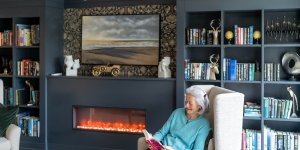OPINION: Dementia and the dining experience
Richard Woodward, general manager of the care homes division at apetito, highlights the importance of dining room design in care homes, especially for those living with dementia

Mealtimes are one of life’s simple pleasures, a pleasure that cannot be underestimated. The environment in which we eat, the way food is presented, and the company in which it is eaten, all have a role to play in the satisfaction and enjoyment of our meal. However, many aspects of a dining room that often go unnoticed can have a huge impact on the mealtime experience for residents living with dementia. With some 70% of care home residents having either dementia or severe memory problems, dining room design is therefore key.
Whether a refit, a new build, or simply making changes to an existing dining room, there are some good rules of thumb to bear in mind that can have a positive impact and make a real difference to the overall dining experience for somebody living with dementia. Too many stimulations and distractions can be overwhelming, which prevents an enjoyable dining experience, in turn reducing the opportunity for good nutritional intake, which can affect quality of life.
HOW TO CREATE THE RIGHT AMBIENCE AND ENVIRONMENT
The key consideration is to create a calm and welcoming environment that is also safe, practical, and easy for residents with dementia to navigate.
For this reason, we recommend you stick to neutral colour tones that add warmth but are not over-stimulating. Busy, brightly patterned wallpaper can act as a distraction, as well as making it difficult for residents with dementia to locate people or objects, and to navigate through the room
Having neutral walls with maybe one single ‘feature’ wall is a great way to incorporate colour without being overstimulating and will also help residents to determine the space of a room because of its obvious contrast compared to the other walls in the room.
The careful use of artwork and pictures on the walls is another way to gently add some colour and stimulation to the room without being confusing. Choose pieces which tie in nicely with the chosen theme for the room, using colours that coordinate with the feature wall.
Try to use soothing imagery - such as beautiful and appetising images of food and meals that make sense with the dining room and stick to the colour palette - to enhance the room. Most importantly, keep things minimal, with just one or two large statement pieces on the wall.
Whenever possible, paint should be in a matte finish and not gloss. This is because a glossy surface can look wet or slippery due to the negative effects of glare for residents as this can be very confusing or distressing. For these reasons, laminate finish should be avoided.
In general, colour perception diminishes with age as vision gets weaker, so it becomes harder to judge the space of a room and navigate independently. The use of colour contrast through paint is an effective tool to help everyone interpret the physical environment of the room, especially for people with dementia, as their vision may be even more impaired.
As a general rule, a 20-30% Light Reflectance Value (LRV) difference in paint between adjacent surfaces is sufficient for most people to understand environments more easily, judge the space of a room, and navigate independently
For visually impaired residents, it is useful to be able to make out a certain level of contrast in everyday lighting conditions; however, it may still be useful for walls, dado rails, and skirting to be painted with different light reflectance in mind.
From a safety aspect, flooring should be consistent throughout the room. Rugs, for example, may be mistaken as puddles or holes or have a ‘trip’ risk factor. Similar colour contrast principles apply to the floor, which should sufficiently contrast with skirting/walls and not be too bright or distracting
We would suggest that a hard flooring is best for a dining room as any spillages can easily be wiped up, removing the risk of falls.
DINNER BY CANDLELIGHT?
While dimmed lights and candles can help to create a relaxed mealtime for many of us, this will not help to enhance the dining experience in the care home. Aside from the obvious safety risk, normal age-related changes in vision often mean that more light is needed to see. For people living with dementia, this need is even greater.
Having a well-lit room, especially with natural light, can improve perception because it helps enable the performance of tasks and reduce falls, allowing everyone to function more independently because they can see better.
Effective natural light is particularly helpful for people with dementia who may have disturbed sleeping patterns, because it controls the body’s circadian rhythm (body clock), helping to regulate sleep, which can improve their mood.
TAKE THE TIME
Mealtimes are a very important time of day and should not be rushed; residents may need time to settle into the dining room, taking in their surroundings before eating.
Think of it as an activity and an opportunity to encourage social interaction and reminiscence. Food often triggers childhood memories, and soothing background music at a low volume can enhance the ambience.
Try to plan mealtimes around when medications are not required, so as to avoid distractions which may take focus away from eating. For dementia residents, who can be easily overwhelmed, allowing for longer mealtimes can alleviate the stress of finishing a meal in a short amount of time
A welcoming, relaxing, and comfortable dining experience has the potential to increase food intake and social interaction, which can also make mealtimes more enjoyable and help to reduce eating difficulties in people with dementia.
PRACTICAL THINKING
One decision will be the type of table used. Should you pick one large or long table so that residents interact, or lots of smaller ones, giving a more intimate and private setting?
For some care homes, it could be an option to have two dining rooms, giving residents the choice of dining alone or in company. Some people living with dementia enjoy having people around them and sharing mealtimes with other residents can be conducive to eating more. However, others may find it distracting or become alarmed by others and prefer to eat on their own. It is very much down to the individual and how they react.
The type of seating is a further consideration. Dining chairs need to be suitable and practical. Some residents may need chairs with arm rests, whilst others may need to sit closer to the table. Having a variety of options will mean every resident will feel comfortable when dining.
Dementia may affect a person’s coordination or swallowing and, as a result, their ability to eat and drink. There are a number of practical aids that can help those with dementia to eat independently, such as cutlery with cushioned handles that are easier to grip, non-spill cups with large handles, and one-way straws which do not let liquid travel back down.
Investing in a range of specialist equipment will make dining an easier experience for residents, helping to increase their food intake.
FINISHING TOUCHES
Creating an attractive table setting can often be one of the most challenging parts of a dementia-friendly dining room because, while it is important to avoid clutter, it is equally important to create an enjoyable dining table.
One way to create a dining atmosphere through table decoration is through the use of plain-coloured tablecloths that contrast with the plates and stick to the colour palette of the room. It is important that tablecloths are plain and not patterned.
An alternative, potentially more cost effective option is to use white tablecloths or no tablecloth at all, but instead to use coloured placemats or napkins that keep to the theme and still contrast with the plates and table. Again, it is important that placemats are plain and not patterned.
Tables can also be decorated with real or artificial flowers or battery-operated candles as centrepieces, but this is all dependent on the capabilities of the residents. If residents have quite severe dementia and are likely to be confused by a vase and mistake it for a drinking glass, it may be better to use battery operated candles to create a dining atmosphere. If residents are likely to take the items off the table, it is probably best to avoid any centrepieces as they can be distracting and draw attention away from the mealtimes as they become the focus.
Some residents who live with dementia may have difficulties eating and drinking due to visual problems, such as not ‘seeing’ items on the table because they are a similar colour to the tablecloth.
Use cutlery, crockery, and other tableware items in colours that contrast with each other. The colour of the food can also have an effect – for instance, light-coloured foods (such as mashed potatoes) on a light coloured plate may not be very visible.
Contrasting colours tableware is very helpful. There is evidence to suggest that blue plates, in particular, enhance nutritional intake.
This follows research by the Dementia Centre at the University of Stirling which revealed that changing white plates for blue ones meant that people living with dementia could better see the food they were eating - including chicken, mashed potatoes, porridge, white bread, and other typically pale-coloured favourite foods - and as a result, the average intake rose by half a pound a day.
A further clinical trial revealed that food intake increased by 25% simply by switching to blue plates from white plates, again helping to increase nutritional intake.
EXPERMENTAL DINING EXPERIENCE
Here at apetito, the entire care homes team undertook an experiential dining challenge to give us the full flavour of what it is like to dine with dementia.
We trialled eating a meal with weights on our arms, wearing dark, scratched glasses in a setting built to replicate a challenging dining environment – with background noise and dark, busy table settings.
We then trialled the same experience in a light and airy room with dementia friendly tableware and the difference was extraordinary!
It was an incredibly informative experience for the team which provided us with even more motivation to develop new products that will help improve the dining experience for those living with dementia.








